- This article comprehensively
tells you about the different forms of art, dance, crafts, music and performing
arts of Rajasthan.
In part one
we covered Maharashtra, part two
covered Punjab. Here is part three.
Rajasthan, a gateway to the grandeur
of erstwhile regal India! A land of Rajas and Maharajas, elephants and camels,
palaces and forts, valour and sacrifice, dance and music, deserts and sand
dunes; Rajasthan is one of the most popular destinations for tourists. The splendour
and vibrant mosaic of colours that Rajasthan has to offer are deeply enchanting.
Despite urbanization, the people of Rajasthan have preserved their culture and
traditions as a mark of respect to those who were instrumental in making the state
a flourishing land! This article is a humble attempt at articulating the
essence of Rajasthan, through its arts and traditions.
1. Art
and craft of Rajasthan
1.
Sculpture
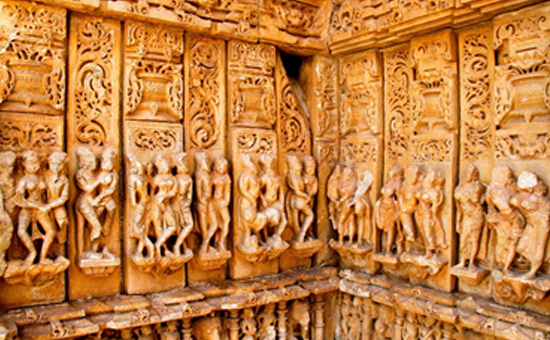 10th century Saas Bahu Hindu temple, Nagda Rajasthan.
10th century Saas Bahu Hindu temple, Nagda Rajasthan.
The state of Rajasthan is replete
with beautiful sculptures of marble, sandstone, stone, and wood. One can find
exquisite stone figures on the walls of the innumerable temples and palaces,
steps of huge wells, on the columns, pillars, courtyards, arches, and domes in
places such as Udaipur, Jaipur, Jodhpur, Bundi, Bikaner, Chittorgarh, and
Jaisalmer. There are awe-inspiring stone carvings of deities at many places of
historical importance all over Rajasthan; attracting both tourists and
aficionados of architecture and structure.
2. Paintings
Rajasthani paintings, like every
other art of the region are exquisite and intriguing. Rajasthani paintings,
known as Rajputi paintings are named after the different Rajput kingdoms in the
state.
Rajput
paintings
 Rajputi painting.
Rajputi painting.
Jaipuri
paintings
 Handmade traditional Jaipuri painting.
Handmade traditional Jaipuri painting.
Jaipuri paintings are a more
formal style of Rajputi paintings. Jaipuri paintings closely resemble the
Mughal style of paintings which depict court settings, scenic nature, and
subjects belonging to varied religions.
Marwar
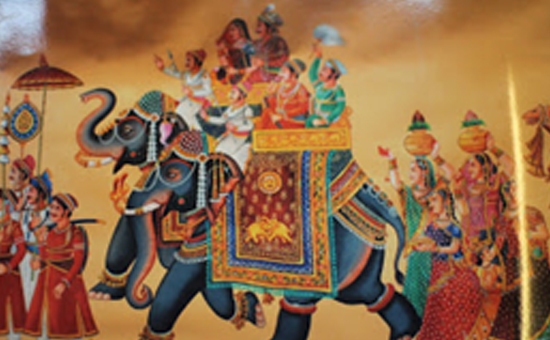 Marwari wall painting.
Marwari wall painting.
Artists under the patronage of
the Rathores of Marwar made paintings that depicted scenes of courts and
princely processions, and of kings performing religious sacraments and rituals.
A striking attribute of Marwari paintings is the depiction of rich decorative
leaves of trees and skies full of thick rolling clouds. Marwari painters made
use of Aniline colours in their paintings, another distinctive feature of this
painting style.
Mewar
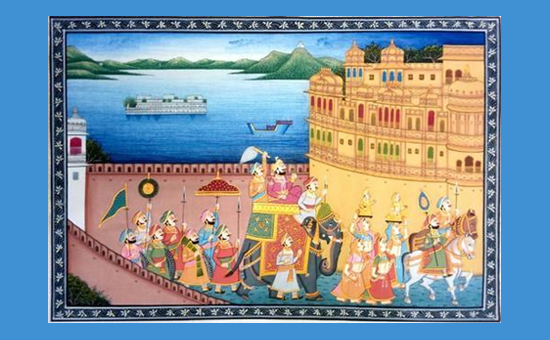 Udaipuri painting.
Udaipuri painting.
Udaipur, in Mewar region of
Rajasthan is known to have a fine taste in music, dance, and art forms. The
kings of this princely state have always patronised art. Very often, Udaipuri
paintings reflect real life events with an aim to archive our past and
reconstruct it. Elegant, decorative designs and bold use of colours are
highlights of the Udaipuri style of paintings.
Bikaner
 A painting similar in style to the Bikaner style of paintings.
A painting similar in style to the Bikaner style of paintings.
The Bikaner style of paintings,
founded by Prince Rao Bika, emerged in this desert princely state about 1488. Initially
Bikaneri artists painted pictures of deities and scenes from religious
scriptures and stories. Some artists then took to painting havelis on canvas,
while others painted fountains and court scenes against a backdrop of nature. The
usage of thick foliage in Bikaneri paintings as if to make up for the desert
conditions is remarkable.
Bundi
and Kota
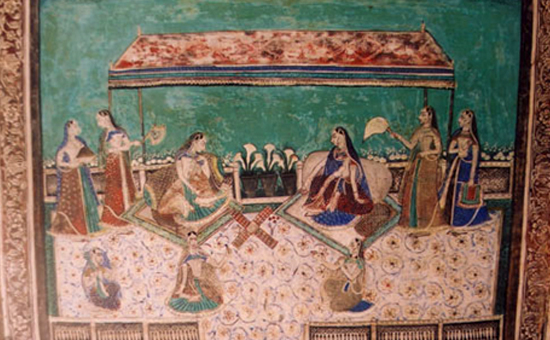 A famous Bundi fresco-painting.
A famous Bundi fresco-painting.
Artists from Bundi and Kota painted
pictures that depicted thick foliage in the background; palaces with intricate
sculptural details, and light of the setting sun. Fresco-paintings from Bundi
and Kota also illustrate scenes of elephant fight, horse and elephant riders,
love scenes (love blossoming in the royal palace courtyards with beautiful
maidens surrounding the royal couple courting each other), and scenes of dance
and drink.
Krishangarh
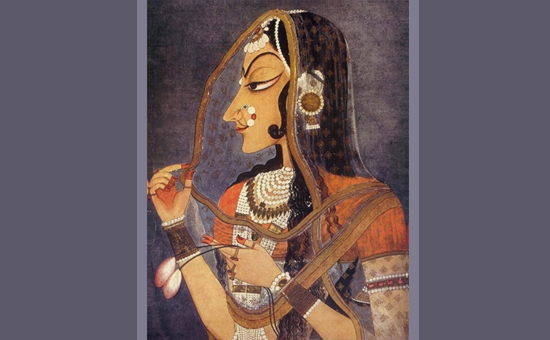 The Bani Thani painting of Krishangarh.
The Bani Thani painting of Krishangarh.
The Krishangarh style of Rajputi paintings is more refined and eloquent than the other Rajputi painting styles. Maharaja Sawant Singh, a king with a passion for art and poetry, gave patronage to many artists in his kingdom; most famous of whom was Nihal Chand.
In the Krishangarh School of art, paintings depicted panoramic landscapes, a lavish use of green colour, and human figures with elongated faces and necks, stylized eyes, drooping eyelids, thin lips, and pointed chin. One of the most famous Krishangarh painting is the Bani
Thani. Such was the popularity of this painting that it was featured
on an Indian stamp issued on May 5, 1973.
Miniature
paintings
 Two beautiful miniature paintings.
Two beautiful miniature paintings.
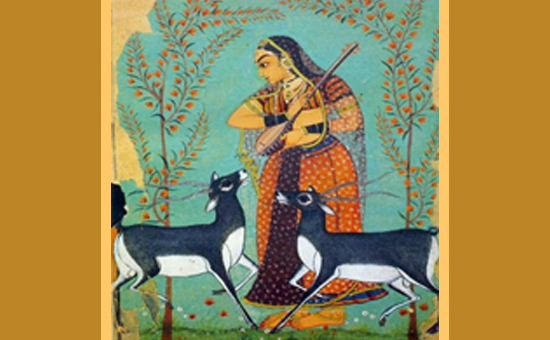
Many an artist have marvelled
over the spectacular miniature paintings of Rajasthan. Painters, brought by the Mughals, trained
Indian artists to produce miniature paintings inspired by the lavish and
romantic lives of the Mughals.
However, as the art form gained
popularity, further transforming into a full-scale Rajasthani school of
painting, artists began to paint names, religious chants and blessings on
things as small as a single grain of rice and pieces of ivory. Few examples of
Rajasthani miniature paintings can be seen in the collection of the folios of Rasikapriya: glorifying the romantic love of Radha and
Krishna.
3.
Jewellery
Rajasthani men and women are
known to wear exotic pieces of jewellery, specific to the region.
Traditional Rajasthani gold jewellery
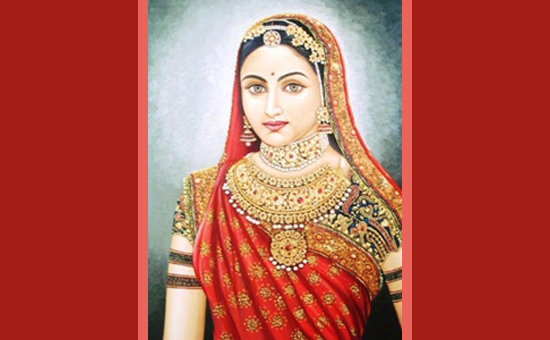 Traditional jewellery for royal women and men from Rajasthan.
Traditional jewellery for royal women and men from Rajasthan.

The typical pieces of gold
jewellery that women wear are timaniyan, bala, bajuband, gajra, gokhru, jod,
rakhri and so on. Men are also known to wear chokers and earrings. These pieces
of jewellery are finely embellished with colourful stones and precious jewels.
Jewellery
of Ivory
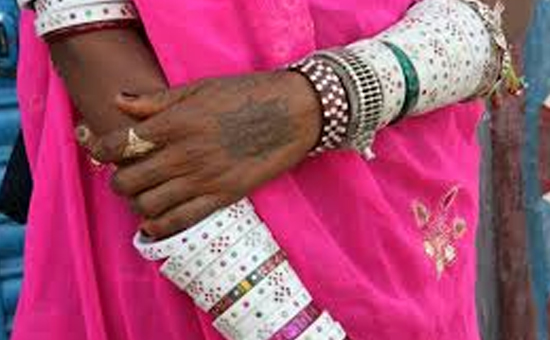 A woman wearing ivory bangles.
A woman wearing ivory bangles.
Ivory (haathidaant) jewellery
found in Rajasthan is considered extremely auspicious by several people of the
older generations. Earlier only ivory bangles were made by craftsmen. Later,
several pieces such as necklaces and earrings started being made from ivory. Given
the excessive poaching of elephants for their ivory, stringent laws have now
been imposed on ivory trade.
Lacquer
and glass jewellery
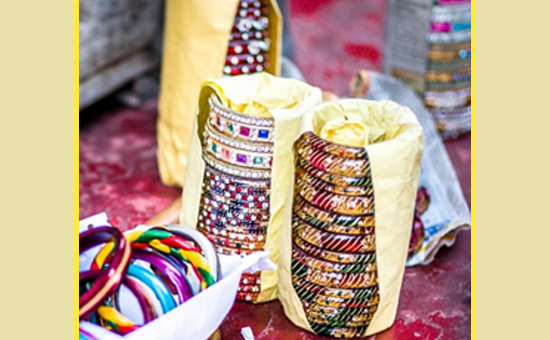 Lac bangles from Rajasthan.
Lac bangles from Rajasthan.
Bangles made from lac, inlaid
with glass and painted in distinct colours are worn on special occasions in
Rajasthan. This art of using lac for making jewellery is further expanded to
make several other decorative items such toys, idols of deities, and functional
items used in kitchens.
4. Meenakari
work
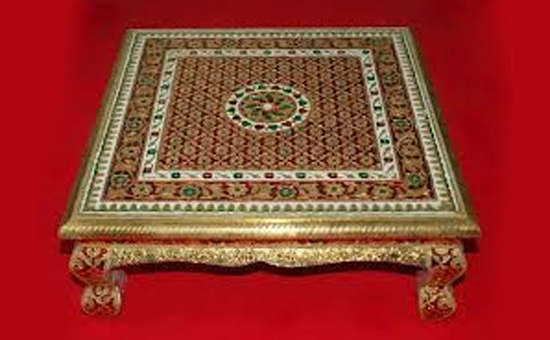 Meenakari work.
Meenakari work.
Meenakari work from Rajasthan,
which today is the pride of Jaipur, was originally imported from Lahore by Raja
Man Singh of Amer. Skilled artisans of Lahore taught the artisans in Jaipur the
fine art of enamel painting. The delicate designs and use of splendid colours
in Meeenakari work are its peculiarities which have been enhanced over time.
Apart from Jaipur, the cities of Pratapgarh and Nathdwara are also known for
their fine enamel work.
5. Tattoo
and Mehendi
Rajasthan is renowned for its
permanent tattoo designs, especially those created by the nomadic tribes and
desert dancers. Mehendi designs from the state once dominated the fashion
market of the world in the late 1990s.
6.
Embroidery
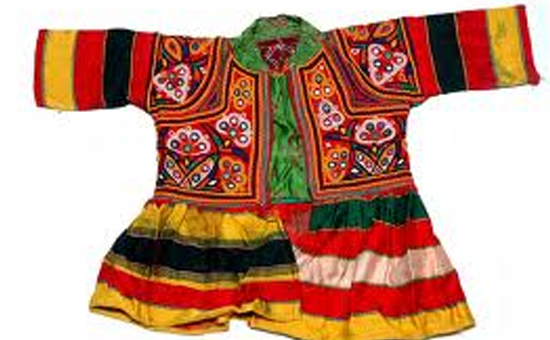 Rajasthani embroidery on the angarkha and ghagra choli.
Rajasthani embroidery on the angarkha and ghagra choli.

Rajasthani embroidery, a needle
work displayed by artisans, is characterised by a beautiful interweaving of
colourful mirrors on cloth. The women of Rajasthan embroider various fabrics
such as quilts, skirts (gharries), shawl, bed covers and many others.
In Rajasthan, some form of embroidery invariably embellishes the three garments worn by women, the kanchli, ghaghras, and odhnis. Similarly, men's garments like the angarkha, achkan, and jama also display certain elements of embroidery.
7. Turbans
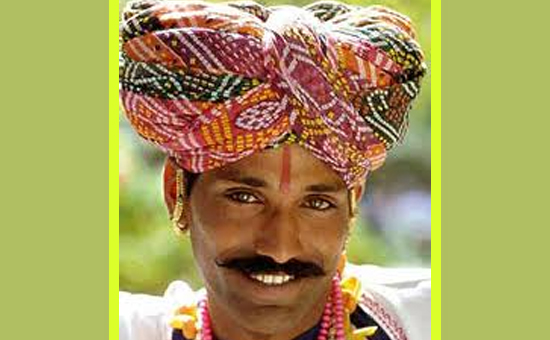 A man wearing one of the many types of a Rajasthani turban.
A man wearing one of the many types of a Rajasthani turban.
The size and shape of the turbans worn by the men in Rajasthan are indicative of a person’s position in society. The turbans worn by the men could be in monotone or could also be extremely vibrant and colourful. For more refer to link ‘Turbans of India’ at the end of article.
8. Puppeteering
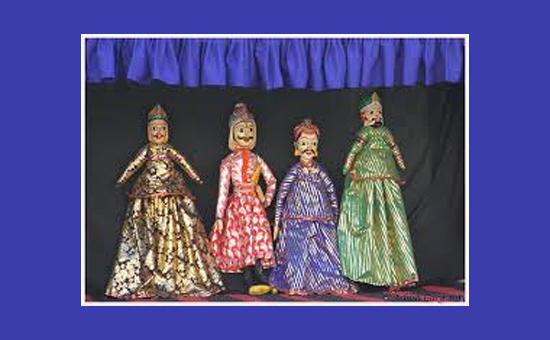 Puppet show in Rajasthan.
Puppet show in Rajasthan.
Rajasthan is known for its
beautiful puppet shows which depict contemporary social and political
scenarios. In the earlier days, puppet shows were used by social reformers to
educate people about various social evils. Puppet shows were also performed in
royal courts to entertain and amuse the royals.
9. DANCES
of Rajasthan
Like all states in India, Rajasthan has its distinctive folk dances. In fact, every region of Rajasthan has its own unique folk dance. Tribal women from the desert region have special dances which are performed on special occasions. Colourful costumes, studded ivory jewellery and intoxicating dance moves are a sight to behold! Some of the most common folk-dance forms of Rajasthan are the Ghoomer, Gair, Chari, Kacchi Ghodi, Kathputli, Bhavai, Drum dance, fire dance, Terah Taali and Maand. Here’s a quick deep dive into each:
Ghoomer
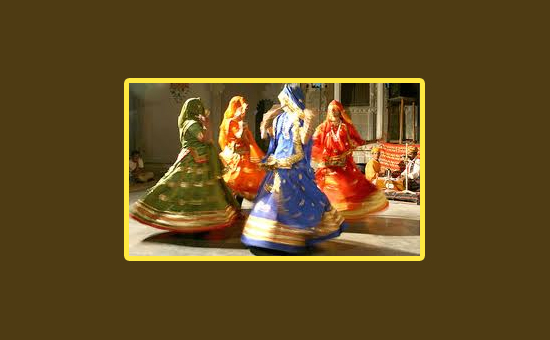 Women performing the ghoomer dance.
Women performing the ghoomer dance.
One of the most spectacular
dances of the Rajput community, the Ghoomer is essentially a dance performed on
special occasions by women folk of the household. Traditionally, this dance is
out of bounds for the men of the household, but this trend is slowly wearing
off as Ghoomer is requested by several well-read tourists paying a visit to the
desert state. In Ghoomer, women twirl around for several hours and this
twirling motion is enhanced by the flair of their flowing skirts. Women
traditionally wear a veil while performing the Ghoomer. A newly married bride
is welcomed into the household with a round of Ghoomer; a tradition that she is
requested to participate in.
Gair
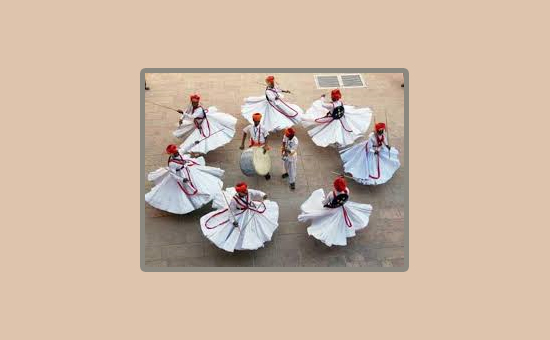 Artists performing the Gair dance.
Artists performing the Gair dance.
Gair is a typical Bhil dance that
is traditionally performed on Holi. Both men and women participate in this
dance. The costume worn while performing the Gair is a simple long flowing
tunic that opens into a full-length skirt, providing flair when dancers move in
the clockwise and anti-clockwise directions. The Gair is known by different
names like Dandia Gair and Greended in the Marwar and Shekhawati regions respectively.
Chari
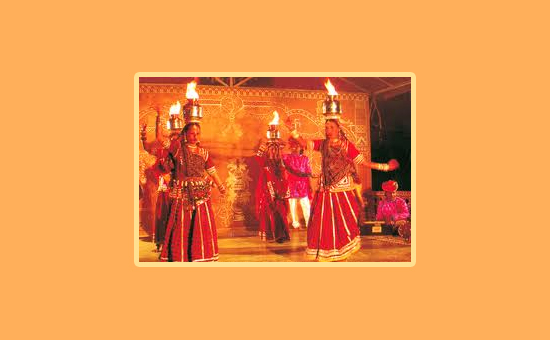 Women performing Chari dance.
Women performing Chari dance.
Chari is the most picturesque
dance form of the state of Rajasthan! Women balance brass pots on their heads.
These brass pots are embellished with small colourful mirrors that sparkle as
the pots sway in tandem with the movements performed by the dancers. In
addition to mirrors, there are flames arising from the cotton seeds placed on
the brass pots. In addition to balancing the pots, women perform deft hand
movements to create striking patterns which make the dance even more alluring
to its audience!
Kacchi
Ghodi
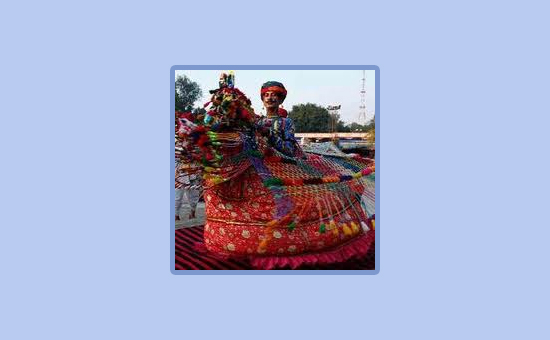 A artist performing Kacchi Ghodi.
A artist performing Kacchi Ghodi.
Kacchi Ghodi, a dance form belonging to the bandit regions of Shekhavati, is performed during weddings to entertain the bride-groom’s wedding party or baraat. Dancers wear costumes to make them resemble horse riders arriving at the wedding. The Kacchi Ghodi troupe comprises ballad singers who sing the praises of bandit Robin Hoods of the region and perform vigorous dance moves indicating mock-fights, sword-brandishing, pirouetting and so on.
Bhavai
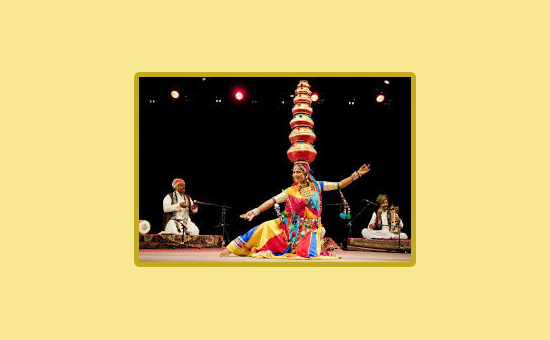 Bhavai performance.
Bhavai performance.
This dance form comprises some
edge of the seat performances! Nimble footed and delicate-looking female
dancers balance brass pots on their heads and dance on glass pieces or edges of
the swords. Today, professional dancers use paper pots that are stuck together
making the act easier to perform. Till date, several tribal and old school
dancers prefer to perform it with real brass pitchers on their heads.
Drum
dance
This dance form from Rajasthan can bring a spectator’s heart into their mouth. A single male dancer holds a single naked sword in his mouth and juggles two to three other razor-sharp edged swords in his hands. His juggling act is performed to the beats played by his troupe and chimes of the cymbals.
Fire
dance
This particular dance form bears
testimony to the faith the Rajasthani people place in their deities. Dancers
perform dance steps on burning coal until they reach a near hypnotic stage
which resembles being one with the Almighty. What is surprising is that the
dancers do not have any blisters to show for all the pain they undergo. These
devotional dancers belong to the Jasnaith
community of Bikaner and Churu regions. They perform the fire dance on winter
nights.
Terah
Taali
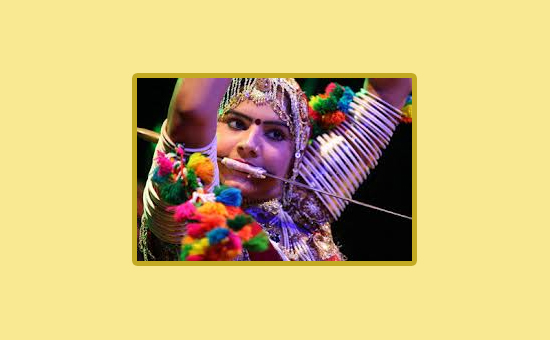 Terah Taali dance performance.
Terah Taali dance performance.
This is another devotional dance
form performed by the women folk of the Kamad community of Pokharan and
Deedwana. It is performed in obeisance to their folk hero Baba Ramdeo. Women hold a sword in the mouth, carry pots and
cymbals in their hands, and tie up to 13 other cymbals to different body parts.
These other cymbals are used to strike the ones held in their hands. It is
their sheer devotion that makes them perform such feats which are otherwise
very difficult to even conceive.
10. MUSIC
of Rajasthan
Three noteworthy forms of folk music in Rajasthan are the Maand, Panihari
and Pabuji ji Phach
Maand
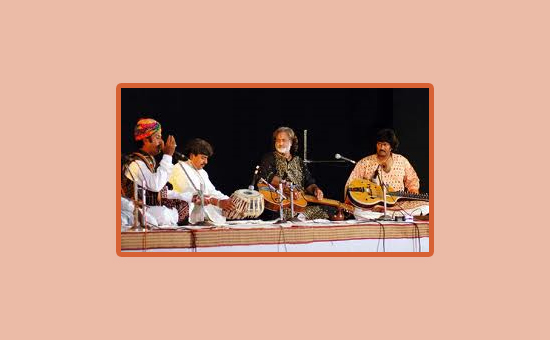 Maand music performance.
Maand music performance.
Maand is a form of vocal music which is based on classical ragas and is now celebrated as a festival in the region of Jodhpur. This original folk form of music which gradually transformed into professional music is used to sing praises of their contribution of previous rulers to the development of the region. Folk songs, such as ‘Kesariya Balam’ have now become an integral part of the tourism campaign of the desert state of Rajasthan.
Panihari
This style of music, developed by hardworking women, originated as women fetching water from afar, belted out melodious numbers singing praises of flowing water and splashing waves – dedicated to water, a scarce commodity in the desert state. Eventually Panihari music gained popularity and encompassed words devoted to daily household chores, unappreciated sacrifices, love and romance, and troublesome in-laws.
Pabuji ki Phach
Pabuji ki Phach, a poetic Ballad
performed by the Bhopa community, is performed to commemorate the gallantry 14th century hero - Pabuji. Rajasthan’s stupendous culture, lifestyle and tradition are narrated in a lyrical style by reading out the verses written on scrolls or Phads which are about 10 meters in
length.
Any note on Rajasthani music is incomplete without the mention of the Manganiar and Langa musicians - Rajasthan’s professional hereditary caste of musicians. While the Manganiar musicians play the Kamaicha – a string instrument played with a bow, the two factions of the Langa musicians play the Sarangi – a string instrument and the Surnaiya - a collection of aerophonic instruments such as the murali, surnai, and satara.
To see pictures of
1. What is described above, see performances at Jaisalmer Desert Festival
2. Bundi Fort
Paintings
3. Havelis
of Jaisalmer shows different types of turbans
4. Kalbelia
Dance
5. Osian Jain
Mandir near Jodhpur
6. Mandore Fort
has lovely Chhatris
7. Turbans
of India